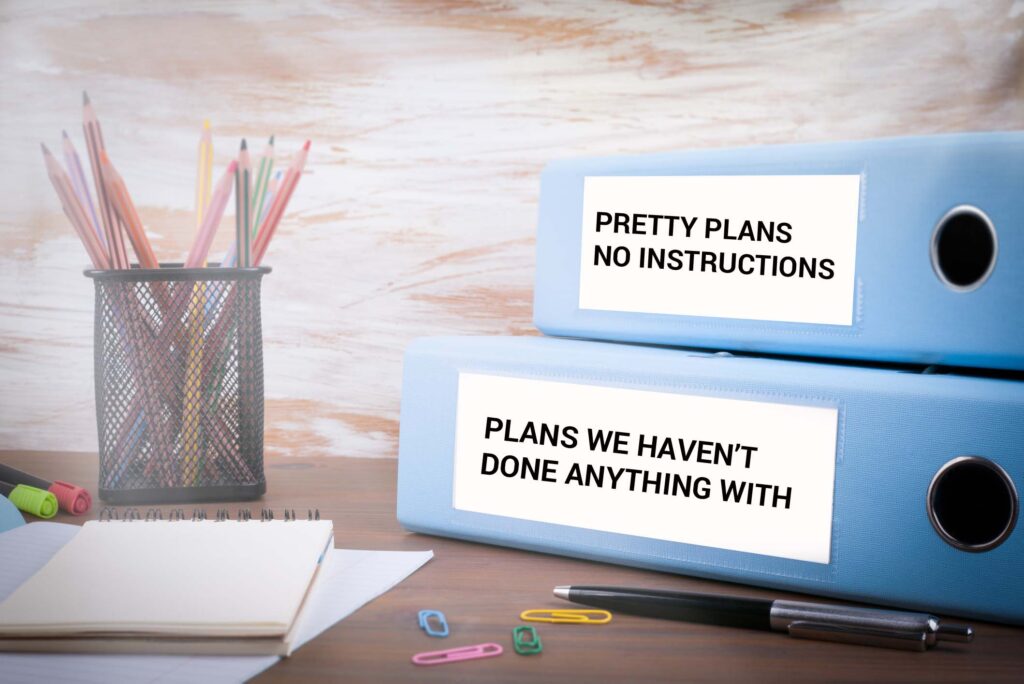We’ve all seen them. If you’ve been in the community, downtown, or economic development worlds for more than five minutes, you’ve seen them. The plans that were paid for, agonized over, and proudly presented, only to have them sit in a binder on a shelf in an office. Maybe you dust them off from time to time. They usually have some good ideas but have never been implemented. They just sit there. Useless because they aren’t being done.
An important part of executing a plan is to start with a good plan. Well, no kidding, right? But what do I mean by a “good plan”? The most important thing to us when we write any plan or strategy is understanding how to actually implement the things you recommend. A good plan will be able to tell you what detailed steps (A, B, C, D, etc.) you need to take to go from idea to finished project. We call this an Implementation Plan. Many firms claim they do Implementation Plans. Few do it well. If you’re hiring someone to do a plan, ask for an example of their Implementation Plans. If it doesn’t look like a detailed spreadsheet (or similar format) using many of the tips below, then you know they don’t know how to do a proper Implementation Plan. You may just end up paying for a very expensive coffee table book.
How to Move from Planning to Doing- Be Specific
The key to moving from idea to action is to be specific. The more specific you can be in putting together an Implementation Plan, the higher your probability of successfully executing the plan. Here’s a list of what I affectionately call, The Six Steps to Get Stuff Done.
- What- This is simply what specifically you need to do, step by step, to get a project done. If a project required three steps, great. If it needs twenty-six steps, that’s fine too. This “What” becomes a checklist that lets you know you’re making progress on a project. It’s also important to realize what your capacity is to do all of the things mentioned in the plan. If your community doesn’t have the ability (people power, money, political will) to do a project in the plan, it shouldn’t be in the plan.
- Who- Who specifically is responsible for executing each step. Try not to put general groups like “Promotions Committee” or “Chamber of Commerce.” Sometimes that is unavoidable, but at a minimum, it should be the chair or staff person’s name on the Implementation Plan for that group. Naming the person in this step is powerful. You are designating them as the person who, from now until completion, will be responsible for the success or failure of the project. The reason you don’t want to name a group is that there is little accountability (more on that below) if a group doesn’t get a project done. There’s much more accountability if “John Smith” or “Sue Jones” doesn’t do what they said they would do. As I said above, this can be the chairperson’s name and the group that gets credit, but that person has to be the one responsible.
- When- When does the project (and each step if you want to be “extra,” as the kids say these days) need to be completed. Again, be specific. Don’t put “2021,” or “Fall 2021.” Put “November 1, 2021.” We, as humans, need deadlines. Non-specific deadlines create wiggle room. Wiggle room is the enemy of getting stuff done. This is not to say if things come up you can’t change the deadlines. You can and should if needed. But the change in those deadlines should be discussed and explained as part of the Review/Accountability process.
- Budget- If a project needs money to do what it needs to do, this needs to be identified up front. However, this is the one area where you might not need the budget to the penny. But you will know whether or not you need money (and roughly how much) to do a project. If the person named is responsible for getting it done, they have to have the resources available to them to make the project a success.
- Success Measurement- How will you know if the project is successful? Defining success gives the person responsible a target to aim for. Be specific and realistic. If you have a façade program you want to implement, pick a number of façades you think is realistic. Maybe that number is one, maybe it’s a dozen. Sometimes the measurement will be “we accomplished X.” But even in that accomplishment include goals and measurables like, “Establish twice-a-week Instagram posts, generating 1,000 followers.” In that statement there are two measurable goals: 104 Instagram posts and 1,000 followers. These measures, like timelines, can be adjusted for circumstances. Lord knows, if we all learned one thing in 2020, it’s we need to be flexible sometimes. If the success measures need to be adjusted, then that should be discussed as well during the Review/Accountability process.
- Frequent Review/Accountability- This is the hardest of all. I always tell people, “Everyone loves accountability until they’re held accountable.” Additionally, the number one thing that happens with a plan once it’s completed is that it goes in a binder and then on a shelf. This is where plans go to die. One of the things we do with our Implementation Plans is we put it in an Excel Spreadsheet. The purpose of the spreadsheet, unlike a printed plan, is that it’s a living document. It can be updated and changed if needed. We always encourage our clients to review the Implementation Plans for the plans and strategies we do for them on a monthly basis. The main reason we encourage monthly is if you only review it quarterly or yearly, if you are coming up on a deadline that someone may have forgot, then the project may only get slightly off schedule versus WAY off schedule or ended up getting scrapped all together. The Implementation Plan, if done using the way described above, becomes a checklist for people to check with on the status of specific steps to ensure they’re on a the agreed upon timeline. Reviewing them monthly provides the accountability we all need to make sure a project happens. If there’s a need to adjust the steps, budget, success measure, or timeline, then you can do it. But it has to be in front of people often so that it doesn’t get put on a shelf and forgotten about.
That’s it. If you do those six things with your plans, you will dramatically improve the probability of moving your plans from paper to reality.
Joe Borgstrom is a principal with Place + Main Advisors, LLC. Place + Main specializes in economic development, downtown and real estate redevelopment, community marketing, and public relations.






